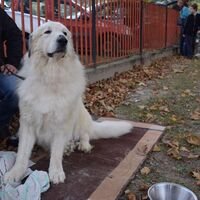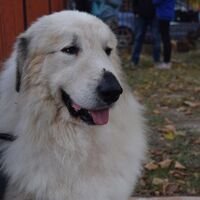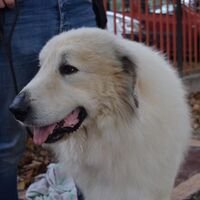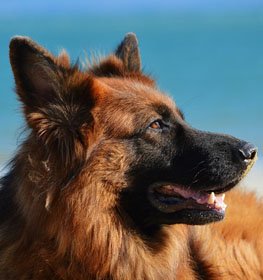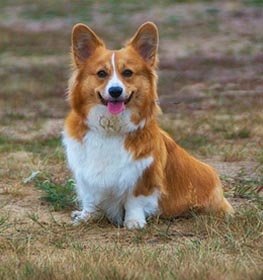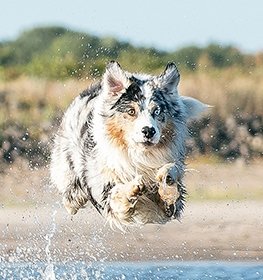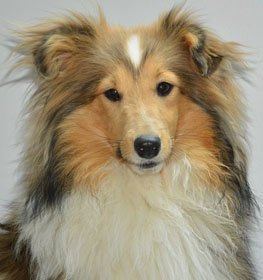Great Pyrenees Information & Dog Breed Facts
Collection of all the general dog breed info about Great Pyrenees so you can get to know the breed more.
| Group | Pastoral / Herding Dogs |
|---|---|
| Popularity Rank | 66 |
| Reviews | 5 |
| User Ratings | |
|
Compare the Great Pyrenees With Other Dogs
Select at least one dog breed to make the comparsion. | |
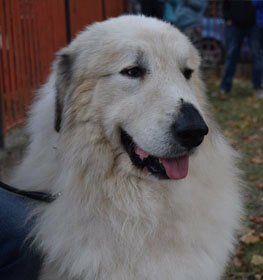 | |
| Origin | |
|
Common Names & Aliases
What other names is a Great Pyrenees known by? Discover all traditional, regional and informal names used for this breed. | Chien De Montagne Des PyrénéesChien Des PyrénéesGos De Muntanya Dels PirineusMontañés Del PirineoPatouGreat Pyrenees |
|---|---|
|
Breed Classification
What type of dog breed is a Great Pyrenees? Learn about its genetic classification and breeding category. | Purebred The Great Pyrenees is considered a purebred dog breed, but many mixes and hybrids have been created from this breed. We have compiled a list of Great Pyrenees Mixes. |
Overview
Photo Gallery of the Great Pyrenees Breed
|
Size Classification
What size category is a Great Pyrenees? Learn how big the Great Pyrenees breed typically grows. | Giant |
|---|---|
|
Weight Statistics
How much does a Great Pyrenees weigh? Discover typical weight ranges for adult males and females of the Great Pyrenees breed. | Male: from 100 pounds (45 kg), Female: from 85 pounds (38 kg) |
|
Average Weight
What is the average weight of a Great Pyrenees? | Male: from 100 pounds (45 kg), Female: from 85 pounds (38 kg) |
|
Height
How tall is the Great Pyrenees? Great Pyrenees height: | Male: 27-32 inches (69-81 cm), Female: 25-29 inches (63-74 cm) |
|
Average Height
What is the average height of a Great Pyrenees? | Male: 29.5 inches (75 cm), Female: 27 inches (68.5 cm) |
|
Price Range
How much does a Great Pyrenees puppy cost? Find current market prices and factors affecting Great Pyrenees costs. | $500-$600 If you choose to purchase the Great Pyrenees, you should know that the mentioned amount of money is an average of the collected data from breeders’ sites and puppy finder places. If you have a Great Pyrenees for sale, please advertise it on a reliable website to make sure the Great Pyrenees gets to a happy place. |
|---|---|
|
Availability
How easy is it to get a Great Pyrenees? How many Great Pyrenees are there in the world? | Very frequent: The Great Pyrenees is quite easy to get. There is a risk of overbreeding, as it is an extremely popular breed. Inbreeding is common because of its popularity. A new study suggests that inbreeding contributes to the incidence of disease and health problems. So be careful, buy from a trustworthy place or kennel and seek the help of an experienced person, a professional, to make the right decision. |
|
Intelligence Rating
How intelligent is a Great Pyrenees? Discover the Great Pyrenees's intelligence ranking and learning capabilities. | Average: It takes patience to teach this breed any tricks or commands, but the effort is worth it. They understand and remember new commands after an average of 25-40 repetitions.
The Great Pyrenees ranks average in the intelligence ranking of dogs. |
|---|---|
|
Training Difficulty
How easy is it to train a Great Pyrenees? Learn about the Great Pyrenees's trainability and response to training methods. | Great Pyrenees dogs are easy to train. They find out the association between commands and actions quite quickly. |
|
Watchdog Rating
How good is a Great Pyrenees as a watchdog? Learn about the Great Pyrenees's alertness and guarding instincts. | Great Pyrenees dogs are one of the best watchdogs. Their main job is to observe and they're very consistent in their effort. The best vocal cords and sense of hearing belong to them. Usually, they're very territorial and protective about their property, so the Great Pyrenees dogs will alert you if they sense something different. |
|
Territorial Protection
Is a Great Pyrenees protective of its territory? Learn about the Great Pyrenees's guarding instincts and behavior. | Great Pyrenees dogs strongly protect their territory. This breed is a complete security guard, so you don't have to be afraid in case of danger. |
|
Personality Traits
What personality does a Great Pyrenees have? Learn about characteristic Great Pyrenees temperament and behavior traits. | ConfidentAffectionatePatientGentleStrongWilledFearless |
|---|---|
|
Sensitivity Level
How sensitive are they? Great Pyrenees sensitivity: | They are a little bit more sensitive than other dog breeds. Soft punishment affects them emotionally. Great Pyrenees dogs don't tolerate irregular daily routines, noisy households, and frequent guest visits really well.
They are receptive to their owner's emotions and make wonderful family companions. |
|
Affection Level
How affectionate are they? Is a Great Pyrenees a good family dog? | Average: Great Pyrenees dogs are average dogs regarding their affection level. Some breeds are forthcoming and friendly, while others are independent and don't bond too closely with their owners. |
|
Social Needs
How much social interaction does the Chien De Montagne Des Pyrénées need? Great Pyrenees social needs: | Great Pyrenees dogs are a social breed. They enjoy being around people or other animals. This breed doesn't tolerate being left alone. |
|
Impulse to Wander or Roam
How likely is the Great Pyrenees to run away? Does this breed explore or wander a lot? Does Great Pyrenees roam? | Great Pyrenees dogs have high wanderlust potential, which means that this breed has a strong desire for exploring the world. Safer to walk them on a leash unless you teach them how to get back to you on command. This breed is also able to cause damage to your fence. |
|
Prey Drive
Do this canine have a strong prey drive? Does Great Pyrenees have high prey drive? | Great Pyrenees dogs have a high impulse to chase and catch something. Cats or any other small animals are in danger. It's a natural instinct, doesn't necessarily mean that Great Pyrenees dogs are aggressive. Better to keep this breed on a leash. |
|
Barking Frequency
Does a Great Pyrenees bark a lot? Learn about typical Great Pyrenees vocalization patterns and triggers. | Average to High: The Great Pyrenees is a vocal breed. Not the best choice if you prefer a quiet breed. They often bark loudly and howl sometimes. They can change their barks depending on their emotional level and what they're trying to say. Different barks could mean the same and the same barks could have different meanings.
Top reasons for barking: protection, alarm, fear, boredom, attention-seeking, greeting, separation anxiety, compulsive barking. |
|---|---|
|
Playful Nature
How playful is a Great Pyrenees? Understand the typical play drive and energy level of the Great Pyrenees breed. | Great Pyreneess are not the most playful dog breed. Sometimes they do like playing, but that's not their favorite activity. |
|
Apartment Adaptability
Can a Great Pyrenees live in an apartment? Learn about the Great Pyrenees's suitability for apartment living. | It is not recommended to keep the Great Pyrenees breed in the home. It does best in the garden, but if you do want to keep it indoors, it should be exercised thoroughly with long daily walks, so you can keep the Great Pyrenees indoors by introducing daily routines. |
|
Lifestyle Adaptability
How adaptable is a Great Pyrenees to lifestyle changes? Learn about the Great Pyrenees's flexibility to new situations. | Great Pyrenees dogs adapt well to lifestyle changes and different living environments. They don't mind moving from one place to another with their owner. |
|---|---|
|
Alone Time Tolerance
Can a Great Pyrenees be left alone? Learn about the Great Pyrenees's tolerance to solitude. | Great Pyrenees dogs do best when a family member is at home during the day or if their workplace is dog-friendly so they can take the dog at work. |
|
Bite Risk Assessment
What is a Great Pyrenees biting potential? Learn about the Great Pyrenees's bite risk factors. | Low 🔽 The Great Pyrenees has a low chance of biting somebody. Top reasons for dog bite: protection, pain, excitement, herding instinct, being provoked. (Data based on the available online bite statistics.) |
|---|---|
|
Mouthing Tendency
Is a Great Pyrenees mouthy? Learn about the Great Pyrenees's tendency to use mouth during play. | Great Pyrenees dogs have a lower than average tendency to nip, chew, playbite, or herd people. It's a common habit during puppyhood, not aggressive behavior. These "bites" don't hurt, but Great Pyrenees dogs need to be taught a good attitude. |
|
Bite Strength Rating
How strong is a Great Pyrenees bite? Learn about the Great Pyrenees's bite force measured in PSI. | Above 400 PSI 🔼 Great Pyrenees bite force: The Strongest. The Great Pyrenees bite force is among the strongest in the canine world. The bite force Great Pyrenees measurements are typically quite high, which is a testament to their powerful and large stature. The bite force of Great Pyrenees dogs is impressive, and their Great Pyrenees bite PSI is reflective of their powerful nature.
The Great Pyrenees PSI bite should be respected, and appropriate precautions should be taken when interacting with these dogs. The PSI of a Great Pyrenees bite is high, making them one of the strongest breeds in terms of bite force. They are very protective of themselves and their families, therefore a dog bite from them could be exceptionally dangerous with their PSI being above 400. To ensure a well-behaved and controlled dog, it's important to learn how to train a Great Pyrenees puppy not to bite from an early age. It is important that they’re trained to be around others safely. |
|
Average Lifespan
How long does a Great Pyrenees live? Learn about the typical lifespan of the Great Pyrenees breed. | 10-12 years The average lifespan of Great Pyrenees: 11 years |
|---|---|
|
Climate Tolerance
How well does a Great Pyrenees handle different weather? Learn about the Great Pyrenees's climate adaptability. | Prefers cold weather The Great Pyrenees can adapt well to harsh weather conditions, and also can be a good mountain dog. Dogs can suffer from frostbite and hypothermia in extremely cold weather, so it is important to take precautions to keep your dog safe and comfortable during the winter months. |
|
Health Concerns
What health issues are common in a Great Pyrenees? Discover typical conditions affecting the Great Pyrenees breed. | Great Pyreneess are commonly healthy dogs. Vet costs aren't expensive with this breed. |
|
Vet Care Frequency
How often does a Great Pyrenees need vet visits? Learn about the Great Pyrenees's veterinary care requirements. | Rare The Great Pyrenees should have a complete physical check-up at least every 12-18 months (but preferably once per year). If your dog shows any symptoms, call your veterinarian. |
|
Health Problems
What genetic/health problems does the Great Pyrenees breed have? What are the health issues and concerns of the Great Pyrenees breed? Most common health risks of Great Pyrenees: | Cataracts Hip Dysplasia Patellar LuxationBloatEntropionDrug SensitivityElbow DysplasiaAddison's Disease |
|
Energy Rating
How energetic is a Great Pyrenees? Understand daily activity needs of the Great Pyrenees breed. | Great Pyrenees dogs have a higher energy level than other dog breeds. If you want a dog for snuggling on the couch, this breed isn't the perfect choice for you. |
|---|---|
|
Activity Requirement / Exercise Need
How much exercise does a Great Pyrenees need? How much exercise do Great Pyrenees dogs require per day?
Do Great Pyrenees dogs need a lot of exercises? | Great Pyrenees dogs have an average exercise need. This breed is satisfied with short walks every weekday and a long ones on weekends. |
|
Sleeping Need
How much sleep does the Great Pyrenees breed need? | Great Pyrenees dogs don't need too much sleep. They are energetic and desire to live active life. If you think naps are overrated, this breed can be the best choice for you. |
|
Obesity Tendency
Is a Great Pyrenees prone to weight gain? Learn about the Great Pyrenees's obesity risks. | Average to High: If you don't pay attention to the Great Pyrenees's weight, he can easily gain weight. More than one daily walk should be on schedule. To make your dog happy and fit, feed him with quality dry dog food and live an active life together. Try to find the happy medium between exercise and feeding.
If you notice any weight gain, consult your veterinarian and make a diet plan. Reduce unhealthy food and snacks, and measure the Great Pyrenees weight regularly. |
|---|---|
|
Food Consumption
How much food does a Great Pyrenees need daily? Learn about the Great Pyrenees's feeding requirements. | 8 to 10 cups of high-quality dry food a day, divided into two meals |
|
Allergy Friendliness
Is a Great Pyrenees hypoallergenic? Learn about the Great Pyrenees's suitability for allergy sufferers. | No Great Pyrenees dogs don't do well with allergy sufferers by causing allergic reactions. Some dog breeds are even considered to higher possibility of an allergic response. Coat type isn't necessarily relevant, because most people are allergic to dander (flakes on the dog's skin) or saliva, not actually to dog hair. |
|---|---|
|
Coat Colors
What colors does a Great Pyrenees come in? Discover all possible Great Pyrenees color variations. | White |
|
Grooming Requirements
How much grooming does a Great Pyrenees need? Learn about Great Pyrenees coat maintenance requirements. | Average: The Great Pyrenees requires average grooming effort. Cutting the dog's hair by a professional groomer isn't essential. Brushing the dog's coat is useful to reduce shedding. Ears and eyes should be cleaned regularly to avoid infections. Don't skip the seasonal flea treatment too. Dog nail trimming and dog bath can be helpful sometimes. Check the local pet store for dog grooming supplies and find the best dog shampoo to keep its coat healthy and give your dog a pleasant experience of a dog bath. If you don't have the time, skill, or money to take care of your Great Pyrenees, search for a dog groomer or clipping service in your area and book an appointment. Maybe you're lucky to have a dog boarding service that includes grooming or walk-in dog bath places nearby. |
|
Drooling Tendency
Does a Great Pyrenees drool a lot? Learn about the Great Pyrenees's drooling habits. | The Great Pyrenees is a perfect example of a low drooling tendency. If you dislike being covered by slobber spots on your clothes, the Great Pyrenees could be a good choice for you. Drooling is the unintentional saliva flowing outside of the mouth. It can be completely normal or a sign of a health problem. Certain dog breeds drool less than others, just like the Great Pyrenees.
If you notice any change in your dog's drooling habit, you should contact a vet as soon as possible. |
|
Stinkiness Rating
Does a Great Pyrenees smell bad? Learn about the Great Pyrenees's natural odor levels. | Medium ⏺ The Great Pyrenees has an average chance of bad smell. Top reasons for dog stinkiness: infection of bad tooth/ear/skin folds, gas attacks. |
|
Coat Characteristics
What type of coat does a Great Pyrenees have? Learn about the Great Pyrenees's fur characteristics. | DenseDouble |
|
Bathing Needs
How often does a Great Pyrenees need baths? Learn about the Great Pyrenees's bathing requirements. | 3-4 weeks More often than average. These dog coats tend to be longer, softer, and oilier than short-haired breeds. While a good bath every now and then is a great way to keep your buddy from becoming overly smelly, be mindful about overbathing.
Bathing will wash away your dog’s natural oils, while a simple brushing every few days should keep them clean. |
|
Shedding Level
How much do Great Pyrenees dogs shed? How to control, reduce and prevent the shedding of the Chien De Montagne Des Pyrénées? Do Great Pyrenees dogs shed a lot? | Great Pyrenees dogs shed above average. It's a natural process of the hair growth cycle. The amount and frequency of hair loss mostly depend on their health status and breed type. If you don't like vacuum cleaning, you might have to reconsider your choice of having a puppy from the Great Pyrenees breed. |
|
Child Compatibility
Is a Great Pyrenees good with children? Learn about the Great Pyrenees's behavior around kids of different ages. | Great Pyrenees dogs are kid-friendly dogs. This breed is a good choice if you have children. |
|---|---|
|
Pet Compatibility
How well does a Great Pyrenees get along with other pets? Discover the Great Pyrenees's compatibility with other animals. | Great Pyrenees dogs are usually friendly towards other pets. |
|
Stranger Friendly
Are they aggressive or friendly towards/with strangers? Great Pyrenees temperament with other people: | Great Pyrenees dogs are average friendly towards strangers. |
|
Cat Friendly
How well do Great Pyrenees dogs get along with cats? Are they good with kittens? What is this fido's temperament with cats? Can they be good with cats? Can the Great Pyrenees breed live with a cat? | Great Pyrenees dogs are cat-friendly dogs. |
|
Dog Friendly
Is Great Pyrenees good with other dogs? Are they dog-friendly dogs? How well do Great Pyrenees dogs get along with other dogs? | Great Pyrenees dogs are average friendly towards other dogs. |
|
Good For First Time Owners
Is Great Pyrenees breed good for first-time owners? Do they make a good dog for novice owners? Is Great Pyrenees breed suitable for first-time owners? | Yes Great Pyrenees dogs are good for novice owners, due to their easy-going personality. |
|
Office Friendly
Are Great Pyrenees dogs good office canines? Do Great Pyrenees dogs make good office-friendly pets? Can they be office dogs? | No Great Pyrenees is not the best dog breed for office environment. |
|
Senior Citizens Friendly
Are they senior citizens friendly dogs? How well do Great Pyrenees dogs get along with the elderly people? What is the Chien De Montagne Des Pyrénées temperament with senior people? Are Great Pyrenees dogs good for elderly owners? | Great Pyreneess are usually recommended for elderly people. |
|
Service Dog Capability
Can a Great Pyrenees be a service dog? Learn about the Great Pyrenees's service work potential. | Not really This breed generally not used as a service dog. A service dog is a term used in the USA to refer to any type of assistance dog specifically trained to help people who have disabilities, such as visual impairment, hearing impairments, mental disorders, seizures, mobility impairment, and diabetes. Service dogs are protected under the ADA (Americans with Disabilities Act).
Great Pyrenees is not the best breed for service purposes. |
|---|---|
|
Therapy Work Suitability
Is a Great Pyrenees good as a therapy dog? Learn about the Great Pyrenees's therapy work aptitude. | Not really This breed is generally not used as a therapy dog. A therapy dog is a dog that might be trained to provide affection, comfort, and love to people in hospitals, retirement homes, nursing homes, schools, hospices, disaster areas, and people with anxiety disorders or autism.
Great Pyrenees is not the best breed for therapeutic purposes. |
|
Scent Detection Ability
Is a Great Pyrenees good at detection work? Learn about the Great Pyrenees's scenting abilities. | Not really They are not typically employed for this type of work, but there may be exceptional cases. A detection dog or sniffer dog is a dog that is trained to use its senses (mostly its smell) to detect substances such as explosives, illegal drugs, wildlife scat, currency, blood, and contraband electronics such as illicit mobile phones.
Great Pyrenees is not the best breed for detection purposes. |
|
Search & Rescue Potential
Can a Great Pyrenees do search and rescue? Learn about the Great Pyrenees's SAR capabilities. | Not really This dog breed is not typically used as a search and rescue dog. The use of dogs in search and rescue (SAR) is a valuable component in wilderness tracking, natural disasters, mass casualty events, and locating missing people.
The Great Pyrenees is not the best breed for SAR purposes. |
|
Maritime Work Ability
Is a Great Pyrenees good on boats? Learn about the Great Pyrenees's maritime capabilities. | Not really Great Pyrenees breed usually doesn't like being on a boat. Boat dogs were typically bred for their strength, stamina, and water resistance, as they were often required to perform tasks such as pulling in fishing nets, and jumping into the water to retrieve ropes or lines, or helping to move cargo. Sailor dog is a type of dog that was bred to accompany sailors on their voyages. They were typically used for three purposes: as a working dog, a watchdog, and as a companion. A boat dog is a term used to describe a type of dog that was traditionally bred and used as a working dog on boats. |
|
Draft Work Capability
Can a Great Pyrenees pull carts? Learn about the Great Pyrenees's drafting abilities. | Yes A drafting dog or draft dog is a dog bred and used for cart pulling. Dogs bred for this work have strong builds and qualities that are needed, strength and determination.
Great Pyrenees breed is a good choice for drafting purposes. |
|
Military Service Background
Was a Great Pyrenees used in military service? Learn about the Great Pyrenees's military history. | Not really In history, this breed was not really used for combat dog. |
|
Puppy Litter Size
How many puppies does a Great Pyrenees usually have? Learn about typical litter sizes. | 6-9 puppies |
|---|---|
|
Pregnancy Duration
How long is a Great Pyrenees pregnant? Learn about the Great Pyrenees's gestation period. | 60-64 days Reproductive cycle of the female Great Pyrenees: The first period called Proestrus lasts for about 9 days.
During this time the females start to attract males. You can notice by swelling vulva and bloody discharge. The second part is the Estrus when the female is receptive for the male. It lasts for about 3 to 11 days. The sign of the proestrus part is the soft and enlarged vulva. The discharge decreases and lightens in color. The third part is the Diestrus. Normally, it occurs around day 14. In this period the female’s discharge changes for vivid red and coming to its end. The vulva returns to average, and she will no longer permit mating. The fourth part called the Anestrus. The time frame between heat periods normally lasts about six months. |
|
Breeding Frequency
How often can a Great Pyrenees have puppies? Learn about safe breeding intervals. | Once a year. More frequent breeding is not healthy. It is very important not to buy a dog from a puppy mill, where the needs of the pups and their mothers are ignored. It's an inhumane high-volume dog breeding facility, where puppies born several times a year. |
|
AKC Classification
What AKC group is a Great Pyrenees in? Learn about the Great Pyrenees's AKC classification. | Recognized by the American Kennel Club in 1933 as a Working breed. |
|---|---|
|
FCI Classification
What FCI group is a Great Pyrenees in? Learn about the Great Pyrenees's international classification. | Recognized by FCI in the Pinscher and Schnauzer - Molossoid and Swiss Mountain and Cattledogs group, in the Molossian type section. |
|
Kennel Club Recognition
Which kennel clubs recognize a Great Pyrenees? Learn about the Great Pyrenees's official recognition. | American Canine RegistryAmerican Kennel ClubAmerica's Pet RegistryCanadian Kennel ClubDog Registry of America Inc.Federation Cynologique InternationaleKennel Club of Great BritainNorth American Purebred Registry, Inc.American Canine Association, Inc.Australian National Kennel CouncilContinental Kennel ClubNational Kennel ClubNew Zealand Kennel ClubUnited Kennel Club |
Great Pyrenees Pros and Cons
- Training Difficulty: Great Pyrenees dogs are easy to train.
- Health Concerns: Great Pyreneess are commonly healthy dogs.
- Drooling Tendency: The Great Pyrenees is a perfect example of a low drooling tendency.
- Watchdog Rating: Great Pyrenees dogs are one of the best watchdogs.
- Mouthing Tendency: Great Pyrenees dogs have a lower than average tendency to nip, chew, playbite, or herd people.
- Lifestyle Adaptability: Great Pyrenees dogs adapt well to lifestyle changes and different living environments.
- Child Compatibility: Great Pyrenees dogs are kid-friendly dogs.
- Cat Friendly: Great Pyrenees dogs are cat-friendly dogs.
- Senior Citizens Friendly: Great Pyreneess are usually recommended for elderly people.
- Good For First Time Owners: Great Pyrenees dogs are good for novice owners, due to their easy-going personality.
- Draft Work Capability: A drafting dog or draft dog is a dog bred and used for cart pulling.
- Allergy Friendliness: Great Pyrenees dogs don't do well with allergy sufferers by causing allergic reactions.
- Apartment Adaptability: It is not recommended to keep the Great Pyrenees breed in the home.
- Shedding Level: Great Pyrenees dogs shed above average.
- Obesity Tendency: Average to High: If you don't pay attention to the Great Pyrenees's weight, he can easily gain weight.
- Impulse to Wander or Roam: Great Pyrenees dogs have high wanderlust potential, which means that this breed has a strong desire for exploring the world.
- Alone Time Tolerance: Great Pyrenees dogs do best when a family member is at home during the day or if their workplace is dog-friendly so they can take the dog at work.
- Office Friendly: Great Pyrenees is not the best dog breed for office environment.
Great Pyrenees History
Introduction and ancestry
The Great Pyrenees or in its other name, the Pyrenean Mountain Dog is one of the tallest dog breeds in the world. The breed’s ancestry is believed to date back 10 or 11 thousand years to dogs who originated in Asia Minor. Roman records and documents from at least 2,000 years ago, account for a large-sized herding breed, resembling the Great Pyrenees, indigenous to the Pyrenean Mountain region, that divides Spain and France.
Early history and development
Despite these very ancient artifacts, it was not until the early 16th century, that a concrete description of the Great Pyrenees was written. The breed’s description was made by Brother Miguel Agustin, Prior of the Temple de la Fidelissima of Perpignan. He described this pastoral breed, as sturdy and strong, but athletic enough to chase and to bring down even wolves when protecting the livestock. The dogs’ duty was to watch over and guard the flock deter and occasionally fight predators, whether wolves, bears, or livestock rustlers. The breed’s innate patience came in handy when sitting atop a freezing-cold mountain for days on end with nothing to do but to guard the livestock. Their courage when defending the flock was legendary. Later, in 1675, the Dauphin in the court of King Louis XIV declared that the Great Pyrenees was the Royal Dog of France, with the result that it became the guardian of choice for many of the palais and chateaux all around France. This declaration prompted the many in the French nobility to acquire Great Pyrenees and use them to guard estates and personal properties.
Spreading throughout the world
The Great Pyrenees was first exported to North America during the late 18th century, straight to Newfoundland, Canada. It is thought that the breed had a serious contribution to the creation of the Landseer Newfoundland, which is basically the result after cross-breeding the Newfoundland and the Great Pyrenees. Later, throughout the whole 19th century, the Great Pyrenees gained more popularity mainly in England, in Europe, and in the United States of America, after their introduction. The breed was also introduced in the breeding program of St. Bernard in Switzerland, with the intention of re-establishing the population number in the famous hospice where St. Bernard originated. Nevertheless, in the Great Pyrenees’ homeland, the breed started to deteriorate, because of the unscrupulous breeding practices during the early 20th century.
Modern times
As with many breeds, the two world wars took a toll on the breeding of the Great Pyrenees. Fortunately, several specimens were imported to the United States of America before the European continent was effectively closed because of World War II. After the war, breeders, organizations, and associations started serious breeding programs and made efforts with the intention of reviving this old breed. Nowadays, the Great Pyrenees is renowned for its gentle and caring attitude to children and smaller pets, but equally for its qualities as a guard dog. Consequently, the breed is still kept both as a guard dog, and also as a loving family companion.
Latest Great Pyrenees Compares
Great Pyrenees Names
How old is my Great Pyrenees in human years?
You May Also Like
Rate The Great Pyrenees Breed
Great Pyrenees Comments, Reviews and Questions
- HELLO TOO BIG
Jun 12, 2024, 2:35:49 AM:
big boy
- dog fan
Jun 11, 2024, 12:29:10 AM:
- Max
Aug 26, 2023, 4:59:19 AM:
I have a 53% great pyrenees and it's sweet protective smart strong and amazing at killing animals
- lhasa apso
Mar 13, 2022, 5:31:10 AM:
I am about to get a great Pyrenees and I just wanted to ask, are they good with a golden retriever, Saint Bernard, Newfoundland Thanks
- Olivia Hutchinson
Jan 9, 2020, 1:52:38 AM:


